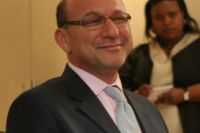Media Release: 5 February 2015
Trevor Manuel remembers Sunday 11 February 1990 as the day he lost Nelson Mandela.
The United Democratic Front activist drove ahead of the convoy of cars carrying Mandela to freedom. He directed his small Toyota onto to the back roads from Victor Verster Prison to avoid the already-clogged main route from to Cape Town.

Trevor Manuel at the Nelson Mandela Foundation (Courtesy: Nelson Mandela Foundation)
He was driving Valli Moosa, Jay Naidoo and the Chair of the Mandela Reception Committee, Cyril Ramaphosa, who had discharged himself from hospital in Johannesburg where he was being treated for pneumonia. On hearing that Mandela would be freed, Ramaphosa had ripped the intravenous drip from his arm and rushed to Cape Town.
As the group approached the city centre they encountered comrade Willie Hofmeyr who warned them not to go to the City Hall from which Mandela was to make his first speech in more than 27 years. The scene was chaotic, people were looting and some had been shot.
A hasty Plan B emerged – Manuel persuaded a security guard he knew at the Cape Town Civic Centre to allow Mandela’s convoy to drive in to the parking area and then lock the gate behind them. He told activist Rose Sonto, who was driving the car carrying Mandela and his wife Winnie, to drive straight there. Manuel and his entourage proceeded to the City Hall to assess the situation. On his return to the Civic Centre, he discovered the convoy had never turned up.
Less than 24 hours earlier he had visited Mandela in prison to discuss the logistics of his release. He found the African National Congress leader “completely calm, relaxed” and in his pyjamas. A far less tranquil Manuel decided that the looming release called for a drink. Warrant Officer Jack Swart poured the drinks but Mandela did not touch his.
“I suppose the most amazing part of that was that he wasn’t showing any emotion,” Manuel recalled of Mandela’s reaction to the news of his release. “Psychologically it was so well embedded in his being.”
“He knew that it wasn’t De Klerk releasing him, that was a physical act. It was the events of the past while that had actually created the conditions for his release and he was his own liberator.”
But now Mandela was free, the world was waiting to see him and Manuel had no idea where he was. He later learned that Sonto had been mistakenly directed to the City Hall and the crushing crowd. As quickly as he could Sonto moved his precious cargo out of town and away from the chaos. They stopped briefly in the quiet suburb of Rondebosch to regroup and plan their next move.
Cell phones were rare then and Manuel was forced to move from place to place around the City Hall looking for Mandela. Finally he was directed to a traffic officer who had someone on his the two-way radio who wanted to talk to him. It was a notorious Security Policeman.
“You must go and fetch Nelson Mandela and bring him now – Over,” he said.
“Yes, that’s what we want to do – Over.”
“You know where he is? – Over.”
“We have an idea,” Manuel lied, realising a political embarrassment was unfolding. Only the day before had and fellow comrades he been told by the Commissioner of Prisons that Mandela’s wellbeing was in their hands.
“I don’t think you know where he is. We can see because we’ve got networks and so on and we’re also using a chopper. He is in Rondebosch East.”
They finally arrived at the house of activist Saleem Mowzer, where they found Mandela, who had taken off his shoes, sitting and sipping a cup of tea.
“I was wondering what had happened to you chaps,” Mandela said.
They finally returned to the City Hall where much of the 60 000-strong crowd was waiting in the fading light. “Madiba was ready to make his speech, the microphone was lousy and he didn’t have spectacles,” said Manuel.
With hastily borrowed reading glasses; his right fist raised in salute Mandela broke his decades-long enforced silence. “I stand here before you, not as a prophet, but as a humble servant of you, the people” he introduced himself.
To rapturous cheers he ended by quoting his own words from the sabotage trial that sent him to jail for life in 1964 with seven other comrades:
“I have fought against white domination and I have fought against black domination. I have cherished the ideal of a democratic and free society in which all persons live together in harmony and with equally opportunities. It is an ideal which I hope to live for and to achieve but if needs be, it is an idea for which I am prepared to die.”
After Mandela joined in the singing of ANC anthem Nkosi Sikelel’iAfrika, the crowd began drifting into the night, and the focus turned to where he would spend his first night of freedom. Archbishop Tutu’s official residence of Bishopscourt was chosen.
Around 4am on the 12th of February just after an exhausted Manuel had fallen asleep, the phone rang. It was the unmistakable, cheerful voice of Nelson Mandela: ‘Hello Trevor I hope I didn’t wake you. You know, when you packed up the car yesterday, what happened to my weights?’
Later that day Manuel was on the lawns of Bishopscourt to witness Nelson Mandela’s first press conference, which he handled like a polished professional.
The weights handed over, “the biggest relief” Manuel joked, was taking them, Mandela and his entourage, “to the airport and they could come to Joburg”.
After a night in a supporter’s house in Johannesburg, Mandela entered his own home in Soweto for the first time in nearly 30 years.
Read: Nelson Mandela's address to rally in Cape Town on his release from prison
Ends
Media Enquiries:
Danielle Melville
+27 82 994 0349